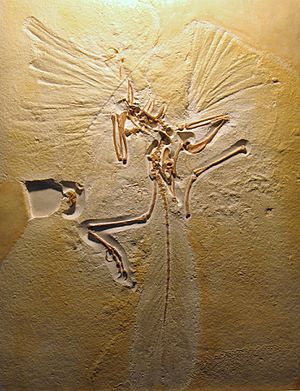Mosaic evolution facts for kids
Mosaic evolution is a cool idea in evolution. It means that different parts of an animal or plant can change at different speeds. Imagine a puzzle where some pieces are brand new and shiny, while others are still old and classic. That's a bit like mosaic evolution!
So, in an animal that's changing over time, some features might stay very old (we call these basal or primitive). But other features might become very new and modern (we call these advanced). This shows that evolution doesn't always happen to everything all at once. Instead, certain body parts or systems can evolve quickly, while others change much slower. It's like different parts of a species evolve at their own pace.
This idea is super important for understanding big evolutionary changes over long periods. It helps us see how animals and plants slowly transform from older forms to newer ones, step by step. We learn about this mainly by studying fossils. While it doesn't happen all the time, mosaic evolution is quite common. Scientists have found many examples across different types of living things.
Contents
Amazing Examples of Mosaic Evolution
Many different animals show signs of mosaic evolution. Here are some of the most famous examples:
How Humans Evolved
When early humans (called Australopithecines) started walking on two legs, their hips changed a lot. This happened long before their skulls or brain sizes grew significantly. So, walking upright was an "advanced" feature that appeared while other parts of their bodies were still quite "primitive."
The Evolving Brain
The brains of mammals are very complex. But different parts of the brain didn't all evolve at the same speed. Some areas changed faster than others, leading to the amazing brains we see today.
Archaeopteryx: A Feathered Dinosaur?
Nearly 150 years ago, a scientist named Thomas Henry Huxley studied Archaeopteryx. This ancient creature lived about 150 million years ago. He compared it to a small dinosaur called Compsognathus. Both fossils were found in Germany.
Huxley noticed that Archaeopteryx and Compsognathus looked very similar. The main differences were the front limbs and feathers of Archaeopteryx. This means that Archaeopteryx had dinosaur-like bones, but with advanced bird-like feathers and wings. The rest of its skeleton was still very much like its dinosaur relatives.
Later studies showed that Archaeopteryx's bones grew much slower than modern birds. It took longer for young Archaeopteryx to learn to fly. A modern baby bird might fly in a few weeks, but Archaeopteryx might have needed about 18 weeks! It also took two to three years to reach its full adult size. This shows that the fast growth and quick flying ability of modern birds evolved much later.
Darwinopterus: A Flying Reptile
Darwinopterus was a type of flying reptile called a pterosaur. It was special because it had features from two different groups of pterosaurs. It had a long tail, like older pterosaurs, but also a skull and neck like newer, short-tailed pterosaurs. This mix of old and new features makes it a perfect example of mosaic evolution.
The Story of the Horse
The evolution of the horse is another great example. Over millions of years, horses changed a lot, from small, multi-toed animals to the large, single-toed horses we know today. But these big changes didn't all happen at the same time. Different parts of their bodies, like their legs, teeth, and size, evolved at different rates.
Mammals in the Mesozoic Era
The Mesozoic Era (the time of the dinosaurs) was also important for mammal evolution. Early mammals showed a mix of features from their reptile-like ancestors and new, advanced mammal traits. This also highlights mosaic evolution.
How Does Mosaic Evolution Happen?
Scientists have learned that changes in special genes can cause mosaic evolution. These genes control how an animal develops from a tiny embryo into an adult. They are like master switches that can turn on or off changes in specific parts of the body. This allows different parts to evolve somewhat independently, creating that "mosaic" pattern of old and new features.
Related pages
- Gene regulation
- Heterochrony
- Neoteny
- Evo-devo
- Convergent evolution
- Macroevolution
- Transitional fossil
See also
 In Spanish: Evolución en mosaico para niños
In Spanish: Evolución en mosaico para niños


